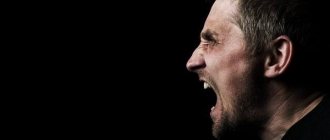In any society there are people who violate the norms of society, go against the rules and moral principles. In this article we will understand what deviant behavior means and what are the reasons for its occurrence.
Deviant behavior is human behavior that deviates from generally accepted norms of society. This behavior differs from the generally accepted one in its motives, values, ideals and means of achieving one’s own goals.
For example, such people may not say hello when meeting, have an “interesting” appearance, act out, or take innovative or revolutionary actions. Young people, saints and geniuses, revolutionaries and mentally ill individuals are most susceptible to this behavior. The behavior of such people, to one degree or another, disrupts the stability of social relationships in the family, on the street, in the team and in society as a whole.
You need to understand that deviant behavior may be the norm for one society or social group, but a deviation for another. It can also be positive and negative.
T. Parsons identifies two types of deviant behavior depending on a person’s attitude towards other people:
- The first type of personality seeks to dominate and subjugate people. This is a manifestation of deviant motivation, which is often observed in criminal gangs.
- The second type of personality submits to other people, makes concessions, or adapts to stronger and more active individuals. So, for example, a whole deviant society was formed under the leadership of Stalin.
There is a broader classification of such behavior developed by Merton. The typology is based on a person’s attitude to standards, their values, and needs. He identified the following types of deviant behavior:
- Total conformism (normal behavior) . This is a person who accepts the norms of society, gets an education, has a job, moves forward, thereby realizing both his own and social needs.
- Innovators are people who agree with the goals of their activities, which are approved by society, but at the same time do not follow generally accepted means of achieving goals. They come up with new and innovative means of achieving goals. For example, these are people who engaged in the privatization of state property, the construction of financial “pyramids”, and “racketeering”. This is precisely the type of deviant behavior that often has a positive connotation. These are the engines of progress.
- Ritualists are people who take the norms and principles of society to the point of absurdity. They demand compliance with all written rules and often go on strike.
- Retreatism means escape from reality. These are people who reject goals and ways to achieve them. This includes homeless people. Alcoholics, drug addicts, monks.
- Revolutionaries are people who reject outdated goals and replace them with new ones.
As can be seen from the above, deviant behavior also has positive manifestations. Thanks to revolutionaries and innovators, society abandons outdated values and goals and moves forward.
Reasons for deviant behavior
Deviant behavior is the commission of non-standard actions and actions that do not fit into the standards of behavior of the majority. Deviation can be positive, expressed in creativity or science, socially neutral or negative.
The causes of deviance include the following groups of factors:
- biological;
- educational;
- social.
Psychological pathologies are classified into a separate subgroup. They are formed at the junction of 2-3 factors and are difficult to treat.
Biological factors
Biological causes of deviance are factors caused by diseases and medical pathologies. These include:
- inflammation, brain injury;
- psychosomatic pathologies;
- depressive states;
- psychoses of various etiologies;
- schizotypal disorder;
- infantility, ADHD;
- schizophrenia.
The reason may also be damage and infection of the fetus inside the mother's womb or during childbirth.
Educational factors
Educational or pedagogical factors appear when a child is raised incorrectly. Among the reasons for this subgroup are:
- negative example set by family members;
- lack of respect between family members;
- excessive severity, unfair punishments;
- indulging all the whims and desires of the child;
- excessive guardianship or lack of guardianship;
- depriving a child of personal space;
- ignoring moral and physical needs.
In addition, deviant behavior occurs in the absence of warm, trusting relationships within the family.
Social factors
Social causes of deviance include factors caused by interaction with other people. The following reasons are noted in this subgroup:
- difficulties in communicating with peers in preschoolers and schoolchildren;
- material, social inequality with others;
- dysfunctional environment: alcoholics, drug addicts;
- the harmful influence of religious sects;
- ridicule, bullying, bullying;
- violence: physical and sexual.
Social factors also include addictions that provoke behavioral deviations. This includes alcohol, drugs, excessive passion for games and subcultures.
Age characteristics
Deviation is not diagnosed in children under 5 years of age. As a rule, it manifests itself most clearly in school, especially in adolescence.
For younger schoolchildren
Psychologists classify deviations of primary school age as:
- inability to nonverbal communication;
- difficulties in establishing interpersonal contacts with peers;
- speech disorders;
- delayed mental, physical or mental development;
- pathological lying;
- masturbation;
- kleptomania;
- sucking fingers and other objects.
With timely identification of signs of deviation in primary schoolchildren, treatment of existing diseases and correction of mental disorders provides favorable prognoses.
In teenagers
For teachers and parents, deviant teenagers become a real disaster. The situation is aggravated by the onset of puberty and the age crisis. Deviations can have dangerous consequences both for others and for the child himself.
Psychologists include the most common deviations of adolescence:
- uncontrolled aggression and even cruelty;
- uncontrollability;
- dromomania - regular running away and leaving home without warning when the teenager does not come to spend the night;
- pyromania - tendency to set fires;
- too impulsive reactions to what is happening;
- anorexia, bulimia and other eating disorders;
- infantilism - actions, actions and whims of a small child that are abnormal for a teenager;
- hyperdynamia - excessive motor disinhibition, pathological restlessness;
- initiation into the use of prohibited substances.
Often teenagers prone to deviation become participants in extremist groups and informal communities. The involvement of such minors in criminal activity is especially dangerous. The consequences can be the most undesirable: from imprisonment to suicide and drug addiction.
As statistics show, deviant teenagers, in the absence of the necessary help and support from others, are characterized by inappropriate reactions even after growing up. Therefore, it is at this age that correction and prevention are so important.
Classification of social deviation
Deviant behavior is divided into positive and destructive forms.
Positive deviant behavior includes:
- scientific achievements and discoveries;
- increased zeal at school, at work;
- creative hobbies and successes;
- participation in charity events;
- heroic deeds, self-sacrifice.
This behavior is considered deviant from the norm, but the deviation is positive.
Negative deviant behavior is the commission of acts and actions that are condemned by those surrounded by the majority. Destructive character deviation can be divided into the following types:
- addictive deviation;
- immoral deviation;
- delinquent deviation.
In turn, these types are divided into several types and subspecies.
All negative types of deviation can manifest themselves in 3 forms of behavior:
- Unconscious deviation. The patient does not understand why his behavior is considered a deviation from the norm, and violates the rules of society unconsciously.
- Nonconformist behavior. A person realizes that his actions and actions do not fit into social norms, and deviates from them intentionally.
- Aberrant behavior. A person understands the unacceptability of his actions, and because of his reluctance to be blamed, he commits them secretly, in secret from others.
Important! Also in psychology, pre-deviant syndrome is distinguished: a complex of symptoms leading to stable negative deviant behavior. It is manifested by conflicts with the environment, increased aggressiveness, and a negative attitude towards study and work.
Addictive deviance
Addictive deviant behavior is a systematic escape from life’s problems, expressed in the form of an unhealthy passion for something, pathological dependencies.
Deviant addiction manifests itself in the form of:
- alcoholism and drug addiction;
- anorexia, bulimia;
- religious fanaticism;
- nymphomania;
- computer addiction;
- workaholism.
Addictiveness can be socially useful, neutral and destructive. Regardless of the subtype, such behavior indicates psychological problems and requires the intervention of a psychotherapist.
Immoral deviance
The subgroup includes deviant behavior that violates moral and ethical social norms. The actions of an immoral person do not pose a serious social danger, but are condemned by society.
Immoral behavior includes the following:
- promiscuity, prostitution;
- vagrancy and begging;
- increased aggression towards people;
- consumption of alcohol, drugs;
- refusal to work, study activities;
- insult, humiliation of surrounding people.
Some classifications of deviant behavior classify the immoral subtype as a socially neutral type of deviance.
Delinquent deviance
The subgroup of delinquent or non-normative behavior includes types of behavior that violate the legal norms of society. They can appear in 2 forms:
- Pre-criminogenic, or illegal type. Violates legal norms. It manifests itself as hooliganism, vandalism, arson of property, fights and beatings, and insults.
- Criminogenic, or criminal type. Violates criminal regulations. Includes robbery, burglary, assault, fraud, extortion, rape and murder, as well as attempted murder.
Delinquency requires strict prohibitive and repressive measures. A person who commits illegal and criminal acts poses a serious threat to society. A delinquent deviant may be subject to forced treatment in psychiatric institutions.
Existing problems
The problem with deviation is that many do not understand its scale. Who among us has not at least once done something that would be condemned by society? Psychologists say that every person has his own “skeletons in the closet,” but they are carefully guarded from prying eyes in order to avoid condemnation. The only question is how dangerous they are. Someone regularly steals strawberries from a neighbor's summer cottage, or smokes in the entrance, or plays music at full volume after 11 p.m. in an apartment building. And someone beats his wife, steals millions from public accounts, distributes drugs. All these are examples from life, but feel for yourself how different they are in their consequences.
The second problem of society associated with deviants is asymmetrical control over them. We often hear about famous people violating social and moral norms. But they usually go unpunished. Although when a simple person commits the same act, the matter is not limited to just condemnation.
Origin of name. The term "deviant" comes from the Latin word "deviatio", which translates as "deviation".
Symptoms of deviant behavior
The symptoms of deviant behavior are very extensive. Common characteristics found in deviant personality types include the following:
- conflicts with peers, surrounding people;
- lack of interest in work, study;
- problems with concentration;
- irresponsibility, unwillingness to help others;
- constant change of hobbies and social circle;
- lack of contact with other people;
- constant mood swings;
- high or low self-esteem.
Deviance can also be manifested by physiological factors: sleep and eating disorders, digestive problems.
Pathogenesis
The course of deviant behavior in adolescents is quite complex. Deviations develop due to a violation of the child’s orientation in the system of social values, norms and rules.
If during the age crisis, when the needs of self-determination and self-expression are heightened, there is no stable system of values, high-quality social conditions and support from a close circle of people, then the teenager develops pathologies of behavioral deviations. During this period, illegal and immoral actions are dictated by the desire to attract attention, to prove one’s strength, independence and significance, and independence.
Diagnosis of deviant behavior
Diagnosis of deviant behavior is carried out by psychiatrists, psychotherapists and clinical psychologists. Deviance is determined by the following methods:
- Examination and conversation with the patient. During communication, the doctor assesses the emotional and psychological state, manner of speech and behavior of the person with deviation. Clarifying questions about family, hobbies and interests are also asked.
- Familiarization with patient data. The specialist reads characteristics from the place of work or study, studies extracts from the outpatient card. If necessary, the doctor contacts the patient’s employer or teachers, or police officers.
- Questioning family and friends. Contact with the patient’s immediate environment helps to understand what kind of relationship the person has with others and in what conditions he lives. It also helps to find out more about the patient’s character and habits.
- Testing, personality questionnaires. Anxiety studies, the Eysenck questionnaire, and the test for deviant behavior (SOP) help determine deviance.
- Projective methods. Art studies, the Szondi and Rosenzweig test allow us to identify the patient’s hidden, suppressed emotions.
Also used in diagnosis are the Minnesota Multifactorial Personality Questionnaire (MMPI) and the Pathocharacterological Diagnostic Questionnaire (PDQ).
Correction and work with social deviation
Negatively deviant behavior must be treated. Correction includes drug therapy, psychotherapeutic correction and auxiliary methods: yoga, breathing exercises.
Drug therapy
It is permissible to use medications for biological factors that provoke deviant behavior. Sedatives and tranquilizers aimed at calming the nervous system can also be used in cases of increased aggression and violence.
| Drug groups | Effect on duality | Examples of funds |
| Normotimics | They get rid of sudden mood swings characteristic of deviant personality types. | Valpromide, Carbamazelide |
| Antidepressants | Regulate the level of neurotransmitters, relieve depression. | Melipramine, Trizadone, Fluoxetine |
| Tranquilizers | Relieves psycho-emotional stress, relieves anxiety, panic and sleep problems. | Diazepam, Phenazepam, Hydroxyzine |
| Antipsychotic drugs | Coping with panic, aggressiveness and tension. Increases patient concentration. | Haloperidol, Quetiapine, Clozapine |
| Nootropics | Strengthen neural connections, improve blood supply to the brain. Improves intellectual abilities and memory. | Picamilon, Nootropil, Glycine |
| Sleeping pills | Eliminates sleep problems: insomnia, night awakenings, increased sensitivity to sleep. | Donormil, Andante, Melaxen |
| Sedatives | Calms, relieves anxiety, stress, panic attacks and excessive aggression. | Valerian, Persen, Novo-passit |
| B vitamins | Strengthens the nervous system, relieves stress, depression and neuroses. | Neurobion, Vitagamma, Milgamma |
Important! In severe forms of deviance, medication treatment is carried out in a psychiatric hospital.
Psychotherapy
Psychotherapeutic methods allow you to correct the patient’s behavior, discover the cause of deviant behavior and eliminate it.
Methods of psychotherapy for deviation include the following:
- individual consultations;
- group sessions with a psychotherapist;
- problem-oriented trainings;
- family therapy, parent training;
- art therapy treatment.
The best effect can be achieved by combining these methods with each other.
Other control methods
The following are used as auxiliary methods to combat deviations:
- physiotherapeutic methods;
- hardening, therapeutic exercises;
- aromatherapy, massage and self-massage;
- breathing exercises, yoga exercises.
To correct the behavior of adolescents and children, active hobbies are also used: sports, tourism and camping.
Consequences
People suffering from deviant behavior are deeply unhappy. They have to pay for their actions throughout their lives. But most importantly, the consequences are not limited to just the individual. They embrace those around them and the entire society as a whole:
- at the personal level: physical exhaustion of the body, mental disorders, social maladjustment, loneliness, death;
- at the level of others: the risk of death and violence, suffering and experiences of relatives and friends;
- at the societal level: criminalization.
Deviation is not only a diagnosis requiring treatment. This is a global problem of modern society. Psychologists and sociologists have long called for solving it comprehensively, at the state level, starting from school. Prevention programs like the one above are implemented by units of educational institutions. No money is allocated from the budget for them; they are not a mandatory component of the school curriculum. If everything were different, there would be much less crime.
Prevention of deviant behavior
{banner_banstat9}
Preventive measures will help prevent deviations in behavior:
- a positive example in the child’s environment;
- building trusting, warm relationships;
- adequate educational measures;
- information and preventive work;
- consultations with a psychologist as needed.
Such methods are only relevant for children and adolescents. In adults, deviations from the norm in behavior occur due to psychological pathologies or in the process of character formation. Prevention in such cases is useless.
What it is?
In most approaches, the concept of deviant behavior is associated with deviant, or antisocial, behavior of an individual.
It is emphasized that this behavior represents actions (of a systemic or individual nature) that run counter to the norms accepted in society, regardless of whether they (the norms) are legally enshrined or exist as traditions and customs of a particular social environment.
A person manifests himself in this way due to inadequate personal formation in the process of socialization and mastery of moral norms, foundations and rules. Such a person’s own behavior (from the point of view of standards of public morality) is controlled to a very small extent.
Pedagogy and psychology, being the sciences about man, the peculiarities of his upbringing and development, focus their attention on the general characteristic signs of deviant behavior:
- an anomaly of behavior is activated when it is necessary to fulfill the (important and significant) social standards of morality accepted in society;
- the presence of damage that “spreads” quite widely: starting from one’s own personality (auto-aggression), surrounding people (groups of people), and ending with material items (objects);
- low social adaptation and self-realization (desocialization) of an individual who violates norms.
It is safe to say that deviation and social maladaptation/isolation are equivalent concepts, since a person cannot successfully exist in a certain (normal, everyday) social environment. That is, he has deviations from the point of view of average behavior, characteristic of most people as representatives of society.
Therefore, people with deviation, especially adolescents (this is the age that is unusually susceptible to behavioral deviations), are characterized by specific properties:
- affective and impulsive reactions;
- significant (charged) inadequate reactions;
- undifferentiated direction of reactions to events (they do not distinguish the specifics of situations);
- behavioral reactions can be called persistently repeated, long-term and repeated;
- high level of readiness for antisocial behavior.
Examples of deviant behavior
An example of positive deviance would be the rescue of a child from a fire by a stranger. Entering a burning house without a special suit or equipment is a brave and courageous act, but it is different from the behavior of most people. Such actions indicate increased social responsibility and are considered deviant.
The immoral type of deviation occurs among persons without a fixed place of residence. They look inappropriate, drink alcohol and drugs, can be rude to people and beg. This behavior does not harm others, but causes rejection and hostility.
A striking example of addictive deviance can be people who are passionate about computer games. Gaming is an interesting and exciting hobby, but for deviants it replaces real life. A person begins to spend all his free time on the computer, spends all his savings on new games, and stops contacting the outside world.
Deviation from social norms is treated using psychotherapeutic methods, yoga and breathing exercises. If the cause of the deviation lies in biological factors, then it is medicated with the help of antidepressants, sedatives and hypnotics, B vitamins. Deviant behavior is easier to prevent by building a warm relationship with the child and conducting conversations.
conclusions
Thus, deviant behavior is determined by social, biological and psychological factors that must be taken into account when raising young people.
Experts believe that deviant behavior cannot be eradicated from society, but at the same time they note that it arises in society against the backdrop of a crisis, when people are not satisfied with the quality of life and are not in demand. According to sociologists, about 85% of the population are demoralized, discouraged and confused. As a result, they become indifferent to the means of achieving goals, corruption, and extremism.
Since no state is interested in people, only a person himself can help himself and his children through self-development, self-tuning and self-extrication. Unfortunately, these are the realities of life: “The rescue of drowning people is the work of the drowning people themselves.”








